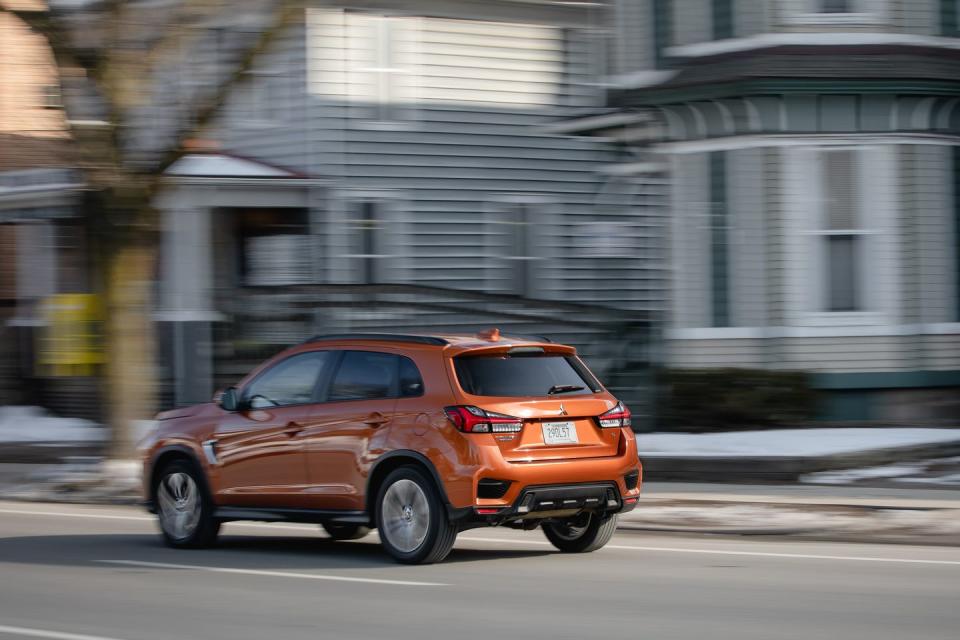2020 Mitsubishi Outlander Sport Is Past Its Sell-By Date

The problem with the 2020 Mitsubishi Outlander Sport, the brand's smallest crossover, is that it was only mediocre when it debuted nearly a decade ago. A sprinkling of new improvements align it slightly better with the pack of newer and nicer SUVs in its sub-$30K competitive space, but the little Outlander remains wholly uncompelling.
Beneath its gleaming, redesigned shield grille, LED headlights, and tacked-on faux fender vents, this is pretty much the same Outlander Sport that arrived for 2011. That means it is still somewhat of a tweener, straddling the subcompact and compact SUV segments. Its direct rivals include the Jeep Compass, the new Kia Seltos, and the Nissan Rogue Sport. Yet, its rear seat is less accommodating for passengers than the smaller Honda HR-V and Kia Soul, both of which also offer more cargo space than the Outlander Sport's 20-cubic-foot hold.

It Goes, Stops, and Turns
The latest update sees the removal of the previously standard five-speed manual transmission. We won't miss it. The standard powertrain for all but the top-range GT model continues to be a 148-hp 2.0-liter inline-four lashed to a continuously variable automatic transmission (CVT), which makes for such a slow (zero to 60 mph in 9.6 seconds) and dreary combination that we'd rather not think about the last one we tested back in 2017. Front-wheel drive is standard and all-wheel drive is a $1500 option on all models.
Upgrade to the GT trim and you'll get a similarly gritty-sounding 168-hp 2.4-liter four mated to the CVT. This setup was sufficient to push our all-wheel-drive test car to 60 mph in an adequate 8.0 seconds. With no simulated fixed gears, however, mashing the GT's accelerator to merge on to a highway produces a substantial 76-decibel groan as the CVT holds the revs near the engine's 6500-rpm redline. Slotting the shift lever to its S (for Sport) position keeps the engine in its powerband yet results in more noise without any uptick in performance or responsiveness. And don't think that the Outlander Sport makes up for its lazy acceleration with impressive fuel economy. EPA combined estimates for the lineup range from 25 to 27 mpg. We averaged a paltry 23 mpg overall, and the GT only rang up 25 mpg on our 75-mph highway test. That was 3 mpg short of its federal rating. The last HR-V we tested returned 30 mpg on the same test.

Despite this Mitsubishi's tidy footprint, its underdamped suspension delivers both soft, ungainly body control on the open road and a tendency to clomp over bumps. Large impacts are felt as much as heard. Our GT, on its 18-inch Nexen Npriz RH7 all-season tires (sized P225/55R-18), held on around the skidpad with a middling 0.81 g of grip and a slow, vague feel to its steering. Pushing past the initial mushiness of its brake pedal saw it stop from 70 mph in a respectable 163 feet. This is a machine built and engineered to every bare minimum.
Aging and Uninspired
Nowhere is that sense of mere adequateness more apparent than in the Outlander Sport's drab plastic cocoon of an interior. Soft-touch points among the swaths of hard surfaces are minimal, and the design, even with the few token chrome flourishes, is as inspired as a copy machine's. Lumpy front seats are a bit small for larger frames and perched unnecessarily high, making it difficult to find a comfortable driving position. While the latest changes see the upgrade infotainment touchscreen grow to 8.0 inches (a 7.0-incher is standard) and fitted with most of today's connectivity options, the plainly rendered, low-res display presents as but a functional necessity. The same can be said for the tiny, pixilated color readout in the instrument cluster.

Pricing for the base ES trim level starts at $23,790, which, despite the almost painful lack of performance under its hood, keeps the Outlander Sport in an appropriately bargain neighborhood. You'll have to pay $25,490 for the SE trim to unlock the Mitsubishi's available active safety technologies, though. Opting for a loaded GT with the 2.4-liter like our test car will set you back $28,720. Even considering Mitsubishi's 10-year or 100,000-mile powertrain warranty, there's simply no justification for that. Given the numerous better alternatives in today's bumper crop of small SUVs, the aging Outlander Sport's substandard execution warrants no rational endorsement.
You Might Also Like

